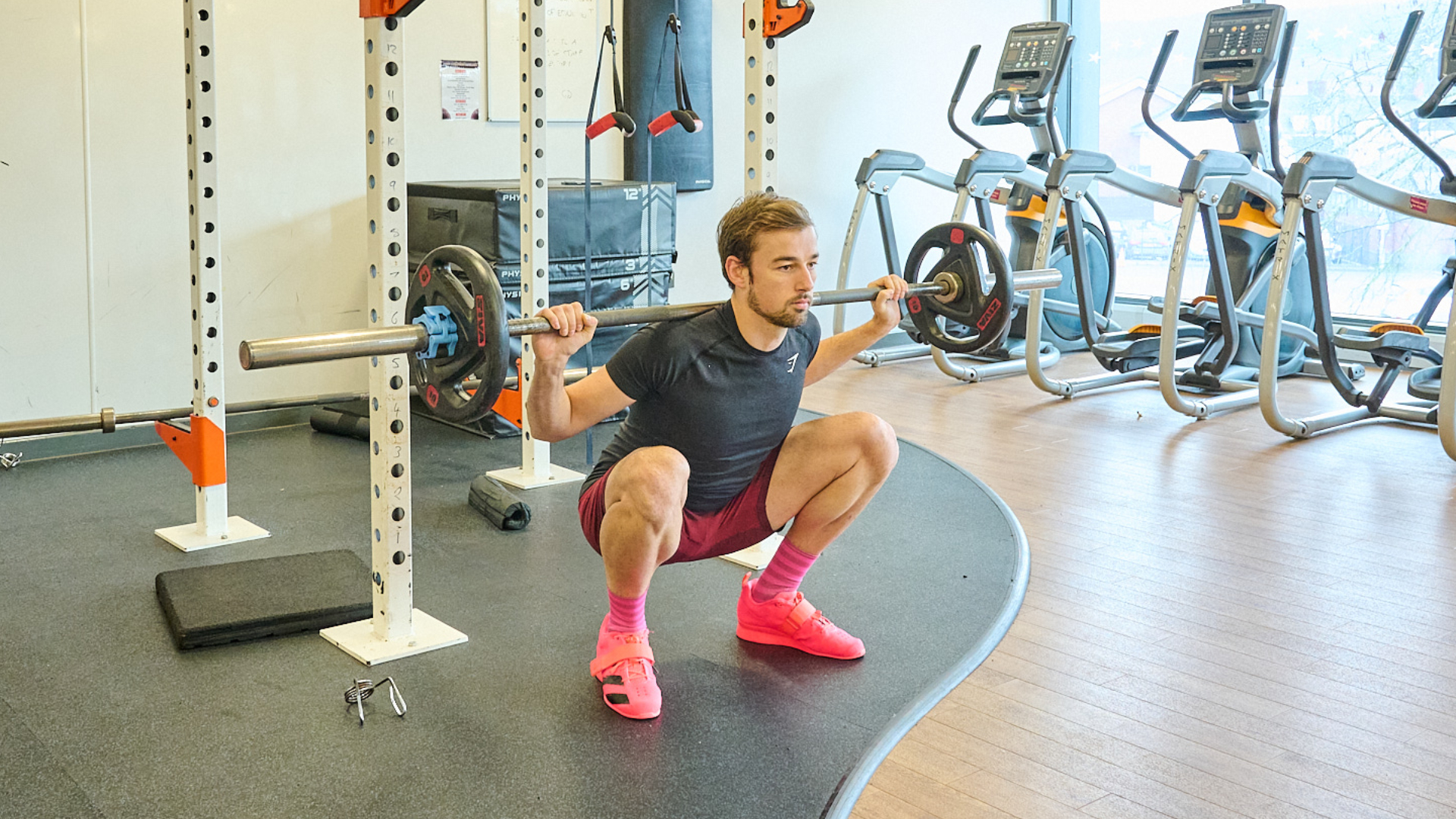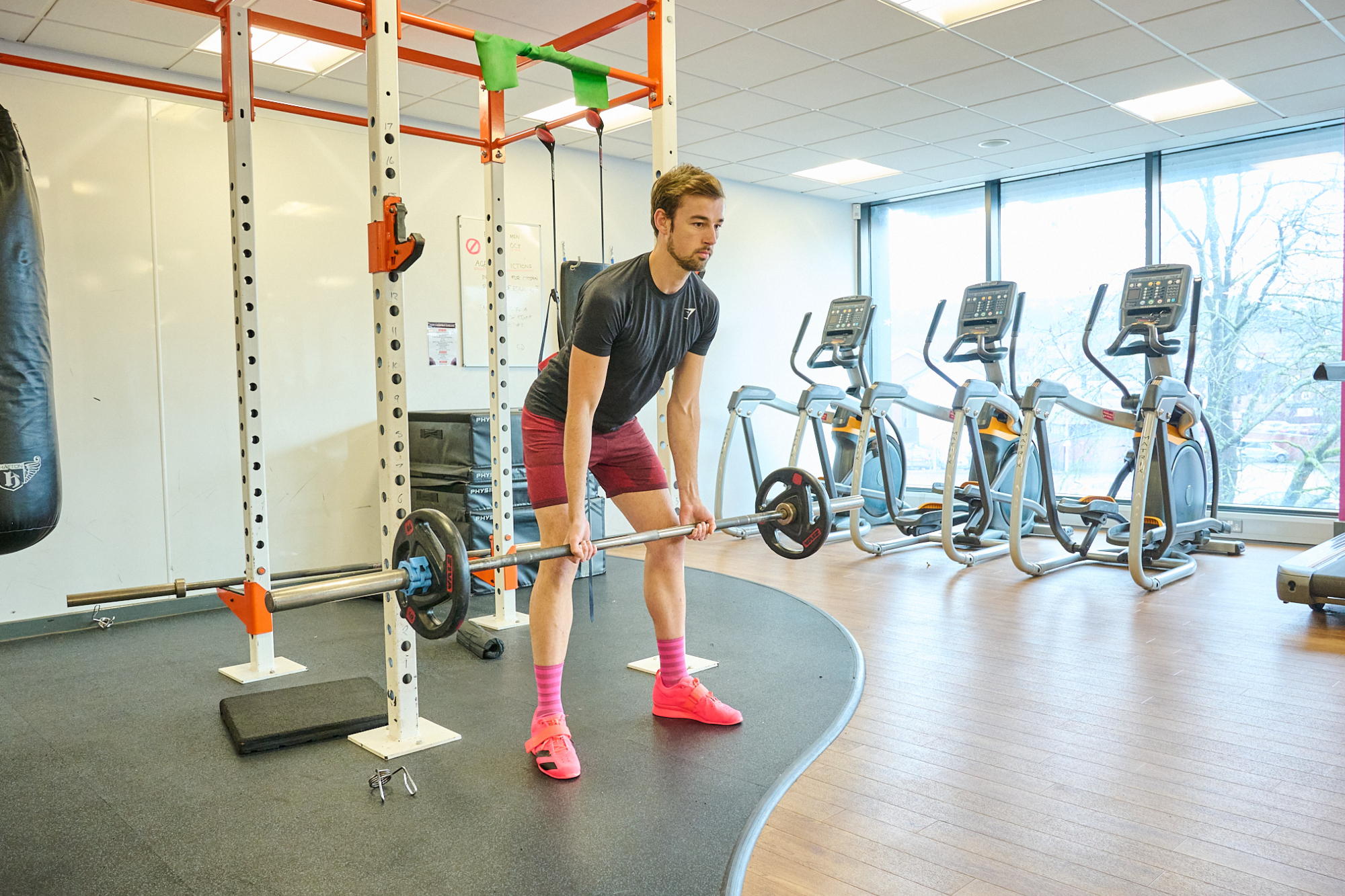I completed this 12-week strength training program for cyclists and here's how it improved my peak power
From five second sprints to 20 minute FTP tests, I saw significant gains across the board


Strength training is something that, in recent years, has gained popularity with cyclists - and for good reason! Although previously the received wisdom was that to get better on the bike, just ride your bike, our understanding is now greatly improved. Much research has been conducted on strength training for cyclists and the findings are that off-bike training - such as time spent in the gym - can be hugely beneficial for sprint performance, time to exhaustion, aerobic performance, and injury prevention.
With this in mind, I enlisted the help of Strength and Conditioning coach Patrick Fotheringham to set me on a 12-week strength program for cyclists to improve my performance on the bike.
As an additional challenge for him, I would be away most of August working at races and with limited access to a gym. I was also recovering from a broken arm and damaged ligament after a left hook from a car. So, being both time and injury limited, what would this strength program look like and how would it help me?
To get me started on my program, the initial work focussed more around movement patterns, range of motion, and explosiveness of movements. A common trend previously used in gym work for cyclists has always been using higher rep ranges. The idea is that as we cycle we pedal with a high frequency, so gym work should be done in the same way.
However, this couldn’t be further from the truth. As Fotheringham tells me: “Firstly, we are using the gym to gain an additional training stimulus, so doing the same thing we would do on the bike isn’t going to bring us any additional benefit to just cycling. As well as that, higher rep ranges generally lead to greater fatigue and delayed onset muscle soreness (DOMS) which can impair training both in the gym and on the bike.”

Cycling has been one of my passions for years, and upon completing my Masters in Strength and Conditioning I decided to combine the two. S&C is a fairly up and coming performance area in endurance sports such as running and cycling, so it's good being part of a growing area. I have recently started my own online company coaching mainly cyclists, providing them with programs, feedback and knowledge. These range from elite U23 riders, to first year juniors, to club cyclists looking to get stronger and fitter.
What's the ideal rep range for cyclists?
For my 12-week strength training program for cyclists, the rep ranges were generally four to six with three to four sets with a rest between sets of one to two minutes. The idea of the strength and conditioning program was primarily focussing on fewer movements per session, but at a faster speed so as to generate higher force, as well as exercises providing an eccentric stimulus.
“Cycling is an entirely concentric force generating sport. It’s great for low impact so you can do large volumes of it, but not very good for optimizing muscle strength and health,” explained Fotheringham. Concentric muscle contractions are when we produce force while the muscle is shortening. While eccentric contractions are when we generate force while the muscle is being lengthened.
Get The Leadout Newsletter
The latest race content, interviews, features, reviews and expert buying guides, direct to your inbox!
Recent research has found that eccentric muscle work is more effective at helping build stronger muscles as well as stronger tendons and ligaments which really helps with injury prevention.
What other benefits does strength training have?
Eccentric work and resistance training are also fantastic for bone health. This is important for cycling, where there have been systematic issues with underfuelling in the pursuit of lower body weight and potentially damaging their bones and lowering their bone mineral density. Cycling is also not an impact sport. This means it doesn’t create a strong stimulus for bones to develop more material inside and thus bone mineral density can decrease if energy availability is not met. As such, cycling also doesn’t assist with age related bone mineral density loss.

Strength training, on the other hand, helps to stimulate the bone mineral building cells called osteoblasts, cells that form bone tissue and help enhance bone mineral density. This is of huge importance not just for injury prevention, but also for longevity of movement and health. “Cycling will help you improve your cardiovascular health, a component that is itself hugely important for longevity, but should be done alongside resistance training to reduce the occurrence of injury and maintain bone, muscle, and tendon/ligament strength,” said Fotheringham.
What my 12-week strength training program looked like
Download this 12-week strength training program in PDF form here
The first few sessions of this 12-week strength training program were quite different as I hadn’t been particularly active outside of riding on the smart indoor trainer for a few months. The initial DOMS made walking down stairs a bit painful for the first couple of days, but after the first week of sessions this had subsided.
One of the limitations I had was that I couldn’t easily deal with force through my right arm while it was extended, after having been knocked off my bike and breaking my arm. To accommodate for this, rather than using weights for work such as bent over rows, I instead used resistance bands. These offered very little resistance while my arm was straight, but increased the tension as I flexed them. Most of the weighted work I did involved weight being held nearer my shoulders so as to give a resistive force without affecting my arm.

Another big focus was work that would help me through a greater range of motion. One of the issues with cycling is overcoming aerodynamic drag, and one of the ways to generally reduce this is to get lower at the front end.
This, however, stretches out the posterior chain, lower back, and shoulders and can result in a loss of power. Muscles work best at a particular range of motion, as can be seen if you do a squat.
Generally, you are strongest from about 90 degrees knee flexion to knees fully extended. Below that, the muscle cross bridges (myosin and actin filaments) struggle to get a good grip on each other so do not produce as much force. Working through a greater range of motion (ROM) for squats, lunges, and Romanian deadlifts, can improve the functional ROM of the muscles around the hips and the knees when cycling.

What this means is that when holding a more aerodynamic position, I did not feel as constricted as when I started and putting out power close to or above my Critical Power - it felt far more sustainable. I also found I wasn’t needing to get out of the saddle as much on longer climbs.
Normally we get out of the saddle in part to open up the knee and hip angle so that our quads and glutes are working in a more optimal ROM. When seated our glutes are benign stretched, while our quads are being shortened outside of the ideal range. Think of an exaggerated low saddle and huge saddle to bar drop. We can’t extend our quads enough to generate optimal force, and our glutes are too stretched to do so. This is because as we get fatigued, the critical torque that we can sustain reduces and so our functional ROM can decrease, hence the need to get out of the saddle to open up those joint angles.
Progressing into the gym

After the first block of the strength training program I was then good to move into the gym and start working with more resistance.
When I first turned up at Halo Leisure gym in Ross-on-Wye, initially I was worried about DOMS, but the at-home work I had been doing had conditioned me nicely moving into the heavier weight phase. The main thing that remained a constant was the lower rep ranges for each set. The reason for this is because a higher rep range means that you have to use a lower weight which will not achieve the same strength stimulus.
“All too often cyclists work on the basis of that because cycling includes a lot of revolutions, you need a lot of reps. But in reality you might as well just ride your bike and avoid the added fatigue of doing 20 reps per set of squats. Rather than the quantity, it is all about the quality and achieving a different training stimulus to unlock the additional benefits that strength training can bring you,” explained Fotheringham.
This is where I really noticed the difference in power output, mainly for sprints. I can normally hit 1000 watts on the turbo quite happily, but not much more as I throw the bike around with my arms a lot out on the road. However, I was now hitting 1100-1200 watts quite consistently on the turbo now.
This is because when we use a high weight and aim for a strength stimulus, the big gains we initially get is neuromuscular recruitment. We have neurons that control a motor unit, a collection of muscle fibers, and when this is stimulated we contract those muscle fibers at 100% force.
For an easy task, only a few units are recruited, for a maximal task we recruit as many as we can. However, without the strength stimulus of lifting heavy weights, we generally do not recruit that many motor units even at maximal forces. It’s why when electrical stimulus is applied to a muscle, most people can contract more motor units and produce more force faster. This is because the neuromuscular pathways are not stimulated to this frequency or velocity during voluntary contractions.
It is also partly due to something called the Golgi Tendon Organ, which inhibits force and velocity of maximal muscle contractions. When you lift heavy weights and produce very high torque, part of the training adaptation is that nerves fire more frequently, thus stimulating more motor units. Additionally these motor units adapt to recruit more fibers per unit. The net result of this is that the maximum amount of fibers that you can recruit increases, as well as the maximum torque, and speed that you contract increases, and the combination of greater force and speed is greater power. Strength training like this can also desensitise the Golgi Tendon Organ which prevents the reduction of force and speed that these stimulate when maximal muscle contractions occur.
Fatigue resistance

Something else I noticed, particularly after doing the strength training program from about week 8 onwards, was my fatigue from sessions didn’t seem to be as much as it had been. Yes, I had been training a bit more, around 5-8 hours a week in general, but due to work commitments I was hardly able to get more than 2-2.5 hours done on the bike at a time. When I was able to get out for longer rides, I did not feel as fatigued as I would expect to come the end of them but in a multitude of ways.
Firstly, my leg muscles were not feeling as tired. Part of this could be that doing strength work with higher torque focus can improve our capacity to recruit Type 2 muscles fibers to assist in producing force along with our Type 1 fibers during endurance exercise. What this means is that the load is being spread between more muscle fibers and our time to exhaustion increases. This also occurs due to greater total muscle fiber recruitment from strength training.
Another thing I noticed was that my respiratory muscles were not as achy. On longer rides especially with long periods of sustained higher power such as longer climbs, I had initially been feeling achy on my ribs and diaphragm. After several weeks of strength training work and doing quite a lot of work on trunk muscles which are partly responsible for inspiration and expiration of air, the aching around my ribs was far less prominent.

The Sandbag pull-throughs and Russian Twists were some of the exercises that really targeted the trunk (core, sides and back) and I think also helped quite a lot with my capacity to maintain a more stable position on the bike over longer duration. This meant less rocking and reduced the chance of my pedalling becoming less efficient as fatigue set in.
Injury management
Finally, for those who suffer from issues such as lower back or knee pain, strength training is likely going to help with this significantly. Even if we have got our bike fit absolutely dialled in, that is still not going to be able to solve problems caused by muscular imbalances. I myself had been experiencing a slight amount of pain in the front of my right knee along with a bit of lower back stiffness. Not only did the strength sessions that Fotheringham gave me have stretching and mobility routines as part of this, but the exercise and lifts themselves really helped with this.

Part of why we can experience lower back pain when cycling is a tight posterior chain, think hamstring, glutes and back muscles. Exercises such as Romanian Deadlifts (an eccentric movement which really stretches and strengthens the posterior chain) are superb for this. When done correctly, they also promote better posture when cycling with better forward hip rotation as many of us who work at desks and spend time sitting have backwards hip rotation and shortened hamstrings. I’m pretty sure that these exercises helped alleviate the lower back discomfort that I had been experiencing.
While the knee pain potentially had been from an imbalance in my quads to my glutes from left to right. Left seemed pretty good, but the right was weaker. For this I was doing split squats to focus on balancing out my legs and also strengthening the right quads. Surprisingly, these benefits to comfort on the bike happened within the first couple of weeks of strength training. There weren’t big imbalances, but it made a big difference quickly.
How effective this 12-week strength training program for cyclists
So, to summarize the overall benefits I felt from the 12-week strength training program for cyclists: fatigue at the end of longer rides seemed to be reduced, breathing felt better, lower back pain and knee pain was alleviated, pedalling felt smoother, and although I was plagued with illness and having to go away for weeks at a time, performance on the bike seemed improved with an increased average speed for the same heart rate on average on the same routes with sprint power increasing significantly.
| Row 0 - Cell 0 | Before | After |
| 5 sec | 1034W | 1112W |
| 1 min | 558W | 581W |
| 5 min | 378W | 389W |
| 20 min | 312W | 342W |
So if you are looking at ways to maximize your training time and improve performance on the bike, there really are tangible benefits to be found from strength training!
Download this 12-week strength training program in PDF form here

Thank you for reading 20 articles this month* Join now for unlimited access
Enjoy your first month for just £1 / $1 / €1
*Read 5 free articles per month without a subscription

Join now for unlimited access
Try first month for just £1 / $1 / €1
Andy is a Sport & Exercise Scientist, fully qualified and experienced Cycling Coach, Sports Director, Freelance Writer, and Performance Consultant. He spent 3 years riding for a UCI cycling team and 7 years as a BC Elite rider, competing in prestigious events such as the Tour of Britain and the Volta a Portugal.
Graduating with a first-class honours degree in Sport & Exercise Sciences, he continues to pursue his interest in research in the field of Sport Science alongside managing his coaching business, ATP Performance. He also works as a Wind Tunnel operator and Performance Consultant at the Silverstone Sports Engineering Hub, working with individuals, teams, and businesses to optimise performance and develop products.
-
 Deuter's 30ltr commuter backpack
Deuter's 30ltr commuter backpackA rolltop bag to fit a change of clothes and a sandwich. And keep them dry
By Simon Richardson Published
-
 The thing that bothers me most when I look back at old school training is that right now we’re doing something equivalently misguided
The thing that bothers me most when I look back at old school training is that right now we’re doing something equivalently misguidedOur columnist's old training diaries reveal old-school levels of lunacy
By Michael Hutchinson Published